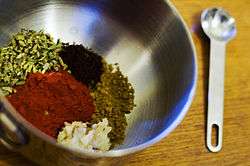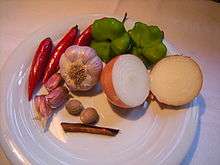Seasoning
Seasoning is the process of adding salts, herbs, or spices to food to enhance the flavour.

General meaning
Seasonings include herbs and spices, which are themselves frequently referred to as "seasonings". However, Larousse Gastronomique states that "to season and to flavour are not the same thing", insisting that seasoning includes a large or small amount of salt being added to a preparation.[1] Salt may be used to draw out water, or to magnify a natural flavour of a food making it richer or more delicate, depending on the dish. This type of procedure is akin to curing. For instance, sea salt (a coarser-grained salt) is rubbed into chicken, lamb, and beef to tenderize the meat and improve flavour. Other seasonings like black pepper and basil transfer some of their flavour to the food. A well designed dish may combine seasonings that complement each other.
In addition to the choice of herbs and seasoning, the timing of when flavours are added will affect the food that is being cooked.
In some cultures, meat may be seasoned by pouring seasoning sauce over the dish at the table. A variety of seasoning techniques exist in various cultures.
Oil infusion
Infused oils are also used for seasoning. There are two methods for doing an infusion—hot and cold. Olive oil makes a good infusion base for some herbs, but tends to go rancid more quickly than other oils. Infused oils should be kept refrigerated.
Escoffier
In Le Guide culinaire,[2] Auguste Escoffier divides seasoning and condiments into the following groups:
Seasonings

- Saline seasonings—Salt, spiced salt, saltpeter.
- Acid seasonings—Plain vinegar (sodium acetate), or same aromatized with tarragon; verjuice, lemon and orange juices.
- Hot seasonings—Peppercorns, ground or coarsely chopped pepper, or mignonette pepper; paprika, curry, cayenne, and mixed pepper spices.
- Spice seasonings— made by using essential oils like paprika,cloves oil and etc.
Condiments

- The pungents—onions, shallots, garlic, chives, and horseradish.
- Hot condiments—Mustard, gherkins, capers, English sauces, such as Worcestershire sauce, Baron Green Seasoning, Harveey's Sauce, ketchup, etc. and American sauces such as chili sauce, Tabasco, A1 Steak Sauce, etc.; the wines used in reductions and braisings; the finishing elements of sauces and soups.
- Fatty substances—Most animal fats, butter, vegetable greases (edible oils and margarine).
References
- Larousse Gastronomique (1961), Crown Publishers
(Translated from the French, Librairie Larousse, Paris (1938)) - Auguste Escoffier (1903), Le Guide culinaire, Editions Flammarion